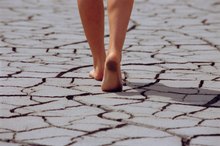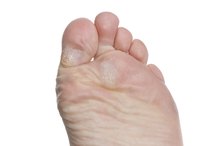What does fact checked mean?
At Healthfully, we strive to deliver objective content that is accurate and up-to-date. Our team periodically reviews articles in order to ensure content quality. The sources cited below consist of evidence from peer-reviewed journals, prominent medical organizations, academic associations, and government data.
The information contained on this site is for informational purposes only, and should not be used as a substitute for the advice of a professional health care provider. Please check with the appropriate physician regarding health questions and concerns. Although we strive to deliver accurate and up-to-date information, no guarantee to that effect is made.
Reasons for Severely Cracked Heels
Cracked heels are a common foot problem, resulting from callused, dry skin 13. Also referred to as fissures, depending on the severity of the problem, heel cracks can lead to bleeding feet and cause extreme pain. Symptoms of cracked heels include dark, yellowing skin on the heel of the foot; callused, hard skin growth; flaky patches; and cracked and peeling skin 13.
Prolonged Standing
Standing for prolonged periods of time, specifically on hard floors, can lead to fissures on the feet. Constant friction and pressure may eventually lead to cracks and open sores which can bleed and cause pain. If you must stand for long periods of time, make sure you wear sensible footwear with adequate cushioning.
Open-Heeled Shoes
What Are the Causes of Sudden Dry Feet?
Learn More
Thin-soled shoes that expose the heel of the foot are among the leading causes of cracked heels 13. According to ePodiatry.com, wearing open-heeled shoes causes the heel of the foot to expand, in turn putting extra pressure on it and making it more susceptible to cracking. Avoid wearing of open-heeled and thin-soled shoes too frequently. Moreover, ill-fitting shoes can also leave you vulnerable to cracked, sore, bleeding heels 13. Always buy shoes with the proper fit for your foot type to give your feet room to breathe.
Obesity
If you are overweight, the simple act of standing can put extra pressure on your feet. EPodiatry.com reports that this "increases the pressure on the normal fat pad under the heel, causing it to expand sideways -- if the skin is not supple and flexible, the pressures to 'crack' are high." Invest in a good pair of shoes to prevent putting too much pressure on your feet, and wear heel pads or heel cups to prevent the heels from expanding sideways 1.
Medical Conditions
Burning Pain on Outside Edge of Foot
Learn More
Medical conditions such as diabetes and an underactive thyroid contribute to inactive sweat glands, leading to dry skin, thus making you more susceptible to foot fissures and cracked heels 13. Other factors contributing to problematic heels include flat feet, athlete's foot and heel spurs 3. Skin conditions such as psoriasis and eczema may also cause cracked heels and feet 13. Apply moisturizing cream to help provide moisture and alleviate excessive dryness of the skin.
Related Articles
References
- ePodiatry: Cracked Heels
- MayoClinic.com: Diabetic neuropathy
- Dr. Foot: Cracked Heels
- Institute For Preventive Foot Health. National Foot Health Assessment 2012. 2012.
- Boutrand LB, Thépot A, Muther C, et al. Repeated short climatic change affects the epidermal differentiation program and leads to matrix remodeling in a human organotypic skin model. Clin Cosmet Investig Dermatol. 2017;10:43-50. doi:10.2147/CCID.S120800
- Kapur S, Watson W, Carr S. Atopic dermatitis. Allergy Asthma Clin Immunol. 2018;14(Suppl 2):52. doi:10.1186/s13223-018-0281-6
- Safer JD. Thyroid hormone action on skin. Dermatoendocrinol. 2011;3(3):211-215. doi:10.4161/derm.3.3.17027
- Hashizume H. Skin aging and dry skin. J Dermatol. 2004;31(8):603-609. doi:10.1111/j.1346-8138.2004.tb00565.x
- Parker J, Scharfbillig R, Jones S. Moisturisers for the treatment of foot xerosis: a systematic review. J Foot Ankle Res. 2017;10:9. doi:10.1186/s13047-017-0190-9
- Linus Pauling Institute. (2012-2016). Oregon State University: Micronutrient Information Center: Essential Fatty Acids and Skin Health.
Writer Bio
Aretha C. Smith began her professional writing career in 2004. She has authored several training guides for Dalhousie University, where she is pursuing a Bachelor of Arts in English. Smith also holds a diploma in library information management from Nova Scotia Community College.









